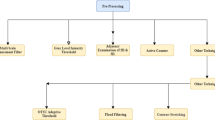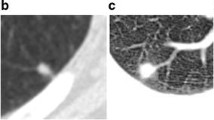Abstract
One of the key problems of computer-aided diagnosis is to segment specific anatomy structures in tomographic images as fast and accurately as possible, which is an important step toward identifying pathologically changed tissues. The segmentation accuracy has a significant impact on diseases diagnosis as well as the therapeutic efficacy. This paper presents a fast and robust weak-supervised pulmonary nodule segmentation method based on a modified self-adaptive FCM algorithm. To improve the traditional FCM, we firstly introduce an enhanced objective function, which computes the membership value according to both the grayscale similarity and spatial similarity between central pixels and neighbors. Then, a probability relation matrix between clusters and categories is constructed by using a small amount of prior knowledge learned from training samples. Based on this matrix, we realize a weak-supervised pulmonary nodules segmentation for unlabeled lung CT images. More specifically, the proposed method utilizes the relation matrix to calculate the category index of every pixel by Bayesian theory and PSOm algorithm. The quantitative experimental results on a test dataset, including 115 2-D clinical CT data, demonstrate the accuracy, efficiency and generality of the proposed weak-supervised strategy in pulmonary nodules segmentation.






Similar content being viewed by others
Notes
Provided by National Institute of Health’s Lung Imaging Database Consortium (LIDC), which is available at https://public.cancerimagingarchive.net/ncia/login.jsf
Provided by Shandong Provincial Qianfoshan Hospital
References
Ahmed MN, Yamany SM, Mohamed N, Farag AA, Moriarty T (2002) A modified fuzzy C-means algorithm for bias field estimation and segmentation of MRI data. IEEE Trans Med Imaging 21(3):193–199
Armato SG, McLennan G, Bidaut L et al (2011) The lung image database consortium (LIDC) and image database resource initiative (IDRI): a completed reference database of lung nodules on CT scans. Med Phys 38(2):915–931
Bakhshali MA (2016) Segmentation and enhancement of brain MR images using fuzzy clustering based on information theory. Soft Comput. doi:10.1007/s00500-016-2210-2
Balafar MA, Ramli AR, Mashohor S, Farzan A (2010) Compare different spatial based fuzzy c-mean (fcm) extensions for MRI image segmentation. In: The 2nd international conference on computer and automation engineering, pp 609–611
Bezdek JC (1976) A physical interpretation of fuzzy ISODATA. IEEE Trans Syst Man Cybern 6(5):387–389
Cai W, Chen S, Zhang D (2007) Fast and robust fuzzy C-means clustering algorithms incorporating local information for image segmentation. Pattern Recognit 40(3):825–838
Chen S, Zhang D (2004) Robust image segmentation using FCM with spatial constraints based on new kernel-induced distance measure. IEEE Trans Syst Man Cybern 34(4):1907–1916
Chuang KS, Tzeng HL, Chen S, Wu J, Chen TJ (2006) Fuzzy C-means clustering with spatial information for image segmentation. Comput Med Imaging Gr 30(1):9–15
Dehmeshki J, Ye X, Lin XY, Valdivieso M, Amin H (2007) Automated detection of lung nodules in CT images using shape-based genetic algorithm. Comput Med Imaging Gr 31(6):408–417
Doi K (2007) Computer-aided diagnosis in medical imaging: historical review, current status and future potential. Comput Med Imaging Gr 31(4–5):198–211
Dong F, Peng J (2014) Brain MR image segmentation based on local Gaussian mixture model and nonlocal spatial regularization. J Vis Commun Image Repress 25(5):827–839
Gu B, Sheng VS (2016) A robust regularization path algorithm for v-support vector classification. IEEE Trans Neural Netw Learn Syst. doi:10.1109/TNNLS.2016.2527796
Guo Q, Zhang C, Zhang Y, Liu H (2016) An efficient svd-based method for image denoising. IEEE Trans Circuits Syst Video Technol 26(5):868–880
Kishore VV, Satyanarayana RVS (2013) Performance evaluation of edge detectors - morphology based ROI segmentation and nodule detection from DICOM lung images in the noisy environment. In: IEEE 3rd international advance computing conference, pp 1131–1137
Krinidis S, Chatzis V (2010) A robust fuzzy local information C-means clustering algorithm. IEEE Trans Image Process 19(5):1328–1337
Kubota T, Jerebko AK, Dewan M, Salganicoff M, Krishnan A (2011) Segmentation of pulmonary nodules of various densities with morphological approaches and convexity models. Med Image Anal 15(1):133–154
Li J, Chen X, Li M, Li J, Lee PPC, Lou W (2014) Secure deduplication with efficient and reliable convergent key management. IEEE Trans Parallel Distrib Syst 25(6):1615–1625
Li J, Dang J, Wang Y (2014) Medical image segmentation algorithm based on quantum clonal evolution and two-dimensional tsallis entropy. J Comput Aided Des Comput Gr 26(3):465–471 (In Chinese)
Li J, Huang X, Li J, Chen X, Xiang Y (2014) Securely outsourcing attribute-based encryption with checkability. IEEE Trans Parallel Distrib Syst 25(8):2201–2210
Li J, Wang Q, Wang C, Cao N, Ren K, Lou W (2010) Fuzzy Keyword Search over Encrypted Data in Cloud Computing. In: Proceeding of the 29th IEEE international conference on computer communications, pp 441–445
Li J, Li J, Chen X, Jia C, Lou W (2015) Identity-based encryption with outsourced revocation in cloud computing. IEEE Trans Comput 64(2):425–437
Li Q, Li F, Doi K (2008) Computerized detection of lung nodules in thin-section CT images by use of selective enhancement filters and an automated rule-Based classifier. Acad Radiol 15(2):165–175
Liu H, Zhang C-M, Su Z-Y, Wang K, Deng K (2015) Research on a pulmonary nodule segmentation method combining fast self-adaptive FCM and classification. Comput Math Methods Med 2015:185726. doi:10.1155/2015/185726
McIntosh C, Hamarneh G (2012) Medial-based deformable models in nonconvex shape-spaces for medical image segmentation using Genetic Algorithms. IEEE Trans Med Imaging 31(1):33–50
Murphy K, Ginneken B, Schilham AMR, Hoop BJ, Gietema HA, Prokop M (2009) A large scale evaluation of automatic pulmonary nodule detection in chest CT using local image features and k-nearest-neighbor classification. Med Image Anal 13(5):757–770
Ortiz A, Gorriz JM, Ramirez J, Salas-Gonzalez D (2014) Improving MR brain image segmentation using self-organising maps and entropy-gradient clustering. Inf Sci 262:117–136
Puderbach M, Kauczor H (2008) Can lung MR replace lung CT. Pediatr Radiol 38(3S):439–451
Reeves AP, Chan AB, Yankelevitz DF (2006) On measuring the change in size of pulmonary nodules. IEEE Trans Med Imaging 25(4):435–450
Shi Y, Eberhart R (1998) A modified particle swarm optimizer. Evolut Comput Proc. doi:10.1109/ICEC.1998.699146
Shi Z, Zhou P, He L, Nakamura T, Yao Q, Itoh H (2009) Lung segmentation in chest radiographs by means of gaussian kernel-Based FCM with spatial constraints. In: The 6th international conference on fuzzy systems and knowledge discovery , pp 428–432
Stelmo M, Aristofanes CS, Rodolfo AN, Marcelo G (2012) Automatic segmentation of lung nodules with growing neural gas and support vector machine. Comput Biol Med 42(11):1110–1121
Szilagyi L, Benyo Z, Szilagyii S (2003) MR brain image segmentation using an enhanced fuzzy C-means algorithm. Int Conf Eng Med Biol Soc. doi:10.1109/IEMBS.2003.1279866
Tachibana R, Kido S (2006) Automatic segmentation of pulmonary nodules on CT images by use of NCI lung image database consortium. Medical Imaging 2006: Image Processing, 61440M, doi:10.1117/12.653366
Wen X, Shao L, Xue Y, Fang W (2015) A rapid learning algorithm for vehicle classification. Inf Sci 295:395–406
Xia Z, Wang X, Sun X, Liu Q, Xiong N (2016) Steganalysis of LSB matching using differences between nonadjacent pixels. Multimed Tools Appl 75(4):1947–1962
Yan F, Tan Y, Zhang QX, Wu F, Cheng Z, Zheng J (2016) An effective RAID data layout for object-based de-duplication backup system. Chin J Electron 25(5):832–840 (In Chinese)
Zhang XF, Zhang CM, Tang WJ (2012) Medical image segmentation using improved FCM. Sci China F 55(5):1052–1061
Zhang Y, Li G, Sun X, Zhou X (2009) Geometric active contours without re-initialization for image segmentation. Pattern Recognit 42(9):1970–1976
Zhu R, Tan Y, Zhang Q, Wu F, Zheng J, Xue Y (2016) Determining image base of firmware files for ARM devices. IEICE Trans Inf Syst E 99D(2):351–359
Acknowledgements
This work is supported by National Natural Science Foundation (61572286 and 61472220), Natural Science Foundation of Shandong Province (2016ZRB01143), University Independent Innovation Plan (201401216), Science and Technology Development Plan of Shandong province (2014GGX101037), and also supported by Fostering Project of Dominant Discipline and Talent Team of Shandong Province Higher Education Institutions. The authors also gratefully acknowledge the helpful comments and suggestions of the reviewers, which have improved the presentation significantly.
Author information
Authors and Affiliations
Corresponding author
Ethics declarations
Conflict of interest
Hui Liu declares that she has no conflict of interest. Fenghuan Geng declares that he has no conflict of interest. Qiang Guo declares that he has no conflict of interest. Caiqing Zhang declares that he has no conflict of interest. Caiming Zhang declares that he has no conflict of interest.
Ethical approval
This article does not contain any studies with human participants or animals performed by any of the authors.
Additional information
Communicated by V. Loia.
Rights and permissions
About this article
Cite this article
Liu, H., Geng, F., Guo, Q. et al. A fast weak-supervised pulmonary nodule segmentation method based on modified self-adaptive FCM algorithm. Soft Comput 22, 3983–3995 (2018). https://doi.org/10.1007/s00500-017-2608-5
Published:
Issue Date:
DOI: https://doi.org/10.1007/s00500-017-2608-5




